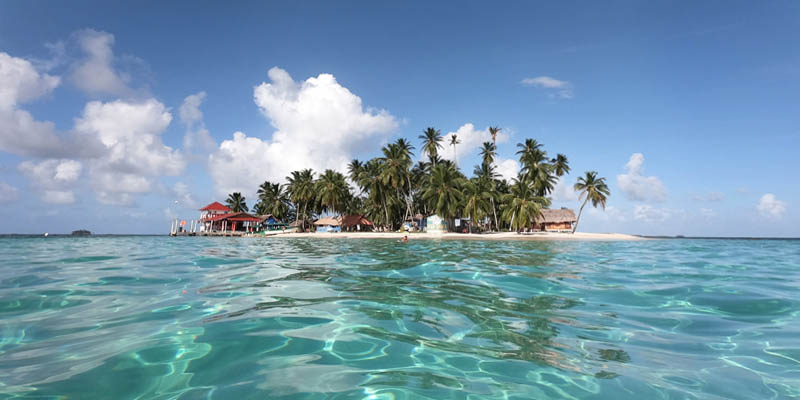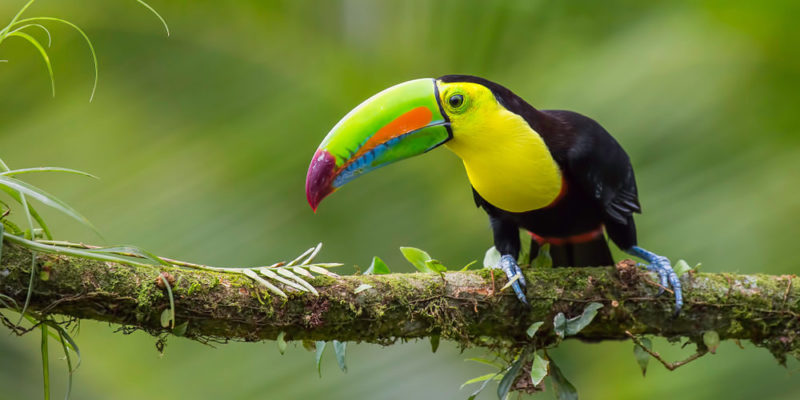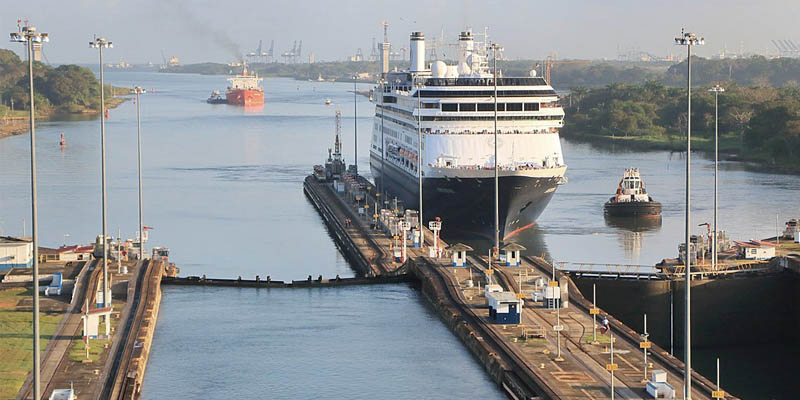We explain what Central America and its physical and cultural characteristics are. In addition, how is its economy, its religion and the history of this region.

What is Central America?
Central America or Central America is the region of the American continent between North America and South America, and is surrounded by the Pacific Ocean in the West and the Atlantic Ocean together with the Caribbean Sea in the East.
The Central American territory includes two geographical areas:
- Istmic Central America. It is the narrow continental strip that joins North America and South America.
- Insular Central America. It is the group of islands that extend over the Caribbean Sea in the Atlantic Ocean. It is divided, in turn, depending on the size of the islands, in major Antilles and Minor Antilles
Central America has an approximate area of 800,000 square kilometers and a population of about 105 million inhabitants.
Why is it called that? The name “America” corresponds to Américo Vespucio, who would have been the first to propose that the land to which the Europeans had reached was a new continent (and not a part of Asia, as believed).
Characteristics of Central America
- It is the central part of America, the most extensive continent in the southern sense.
- America is the second largest continent on the planet, after Asia.
- It presents the Isthmus of Panama, a narrow strip of land that joins two large masses of water: the Pacific Ocean and the Caribbean Sea (an open sea in the Atlantic Ocean).
- The Panama Canal is a navigation route built by the human, which knew how to take advantage of the geographical conditions of the isthmus, and that allows the crossing of ships between the Pacific and Atlantic oceans.
- The official language is Spanish, although about 20 indigenous languages are also preserved. Only in Belize the official language is English, because it is a British ex-colony.
- For the most part, the relief is mountainous and can reach 4000 m SNM has about 60 inactive volcanoes and about 30 active volcanoes in the coastal region of the Pacific Ocean.
Extension, population and countries of Central America
Central America has an area of 800,000 square kilometers, which represents only 0.5 % of the continental surface of the planet.
It is made up of 20 countries and 24 territories dependent on other states, among which Puerto Rico stand out, dependent on the United States, Curacao, Dutch colony, and Virgin Islands, dependent on Great Britain. The most extensive countries are Nicaragua, with 130,000 square kilometers, Cuba with 115,000 and Honduras with 112,000.
The total population of the continent is approximately 105 million inhabitants, representing 1.3 % of the world’s population. Population density is 131 inhabitants per square kilometer. The most populated countries are Guatemala with 17,600,000 inhabitants, Haiti with 11,300,000 and Cuba with 11,100,000.
Physical-Natural Characteristics of Central America

Climate and relief from Central America
The predominant climate in Central America is the tropical climate, which is characterized by having high temperatures and abundant rainfall most of the year.
In general, the region has an average annual temperature, which varies between 24 and 27 ° C, and high humidity, especially on the Pacific and Caribbean coast. In addition, Central America is prone to tropical cyclones and hurricanesespecially between the months of June and November.
In the mountainous areas of the region, such as the mountain range that crosses otmic Central America, temperatures are lower due to altitude.
The relief of Central America is characterized by the presence of mountainous laces that cross it from north to south. It is located on the edge of the tectonic plates of the Caribbean, Cocos, North America and South America, so it is an area of very high seismic and volcanic activity.

Rivers and Lagos of Central America
The Hydrography of Central America is characterized by an extensive network of rivers and lakes that are distributed both in the continental and in the island.
In the continental sector of Central America One of the most extensive rivers is the usumacintawhich flows through its more than 1000 kilometers of extension by Guatemala and flows into the Gulf of Mexico. Another important river is the Lempa, which crosses Honduras, El Salvador and Guatemala, and has a length of around 422 kilometers. The Rio Grande de Matagalpa, in Nicaragua, is also an important river with a length of about 320 kilometers.
In the island of Central America the rivers are shorter and of lower flowbut equally important for water supply and local economies. In Cuba, the cauto river is the longest, with a length of around 250 kilometers, while in the Dominican Republic the Yaque del Norte River is the largest with a length of approximately 296 kilometers.
Flora and Fauna from Central America
The Flora of Central America is very abundant due to the conditions imposed by the warm and rainy climate. This continent presents vast extensions of wild vegetation and forests in the regions near the slopes of the central mountain range. The mahogany is the national tree of the Dominican Republic, where it grows naturally.
Despite the reduced territory compared to the rest of the continent and represent 1 % of the entire earth’s surface, Central America presents 8 % of the natural reserves of the planetwhich house more than 20,000 plant species.
Regarding the fauna, also very varied and abundant, species such as margay, ocelot, jaguar, tsorigüeya, puma, gray fox, coyote, armadillo, anti -war and bezudo bears, manatee, green turtle and iguana stand out.
In addition, snakes are found, such as the constrictor Boa; Birds, such as Quetzales, Papagayos and Tucanes; fish, like sharks; and aquatic mammals, such as dolphins.
Central Culture and Religion
The language that predominates in Central America is Spanish, except in Belize where English is spoken and in some islands, such as Dominica and Haiti, where French is spoken. Besides, languages derived from the native peoples of Americalike Quiché, Mayan language spoken in Guatemala, or Garifuna, an Afro -descendant language spoken in Honduras, Guatemala and Nicaragua.
The religions that predominate today are Catholicism and Protestantism. In addition, Judaism, Buddhism, Islam and other religions of indigenous origin are practiced much less.
Economic Activities of Central America

A particular characteristic that Central America has is the availability of rapid access to both the Atlantic and Pacific Ocean, which facilitates foreign trade in the countries of the region. Through the various maritime routes, Central America developed its economy For internal consumption and for export.
For this reason, América Central presents a large number of ports such as Acajutla in El Salvador, that of Bahía Las Minas in Panama, the Corinth in Nicaragua, that of Puerto Cortés in Honduras and that of Puerto Limón in Costa Rica.
In addition, in Central America it is located one of the main paths of international trade: The Panama Canal. This channel, inaugurated in 1914, facilitates trade between Asia, Europe and the east coast of the United States, which makes it one of the main maritime routes in the world.
The main primary economic activities of the countries of Central America are agriculture, with coffee, banana crops, sugar and cotton cane, and mining activity.
As for secondary activities, The main industries are those that are directly related to agriculture and livestock such as food and beverage production and textile industry.
In addition, tourism is very important in some Antilles islands, especially in Cuba and the Dominican Republic.
Political characteristics of Central America
The countries of Central America can be grouped into those found in the continental sector, and the islands that make up the so -called Antilles.
The continental region of Central America is made up of the countries that are in the isthmus that unites North America with South America.
Insular or Antilles America corresponds to the groups of islands that are in the Caribbean Sea of the Atlantic Ocean and includes an extension that goes from the Florida Peninsula in the United States to the east coast of Venezuela.
The Antilles, depending on the size of the islands, can be classified as Higher Antilles, made up of the largest islands, and in minor Antilles, made up of the islands of lesser extension.
Central American countries are distributed territorially as follows:
| Location | Countries |
|---|---|
| Continental Central America | Belize Costa Rica El Salvador Guatemala Honduras Nicaragua Panama |
|
Older Antilles |
Bahamas Cuba Haiti Jamaica Puerto Rico Dominican Republic |
| Minors | Ancient and Barbuda Barbados Dominica Grenade San Cristóbal y Nieves San Vicente and the Grenadines Santa Lucia Trinidad and Tobago |
All sovereign states of this continent have full representation in the United Nations Organization. In addition, some are part of regional blocks such as the CARICOM (Caribbean Community) and the SICA (Central American Integration System).
History of Central America
Before the European conquest, Central America was characterized by the presence of indigenous peoples that inhabited the regionespecially the Great Mayan Empire, which was located in the current territories of Guatemala, Honduras and Belize.
At the time of the arrival of the Spanish conquerors in the 16th century the region was inhabited by a wide variety of native peoples who had different forms of social, political and economic organization. The Spanish conquest produced a strong impact on the region due to the exploitation of natural resources To be sent to Europe, the imposition of Christianity as religion and slavery of the indigenous population.
During the nineteenth century, most of the countries in Central America achieved their independence from Spain, although many of them suffered internal and external conflicts in the following years. In the twentieth century the region experienced very complex political processes due to dictatorships imposed in many countriescivil wars and revolutionary processes that took place in countries such as Nicaragua and El Salvador.
Continue with:
References
- Cuevas, JM (2020). Central America: common origin, different paths. ELORDENMUNDIAL
- Gil, A. (2021). The political map of Central America. ELORDENMUNDIAL
- Caricom (2020). Annual Report 2020. CARICOM
- Lee Woodward, R. & Bushnell, D. (2023). Central America. Britannica





